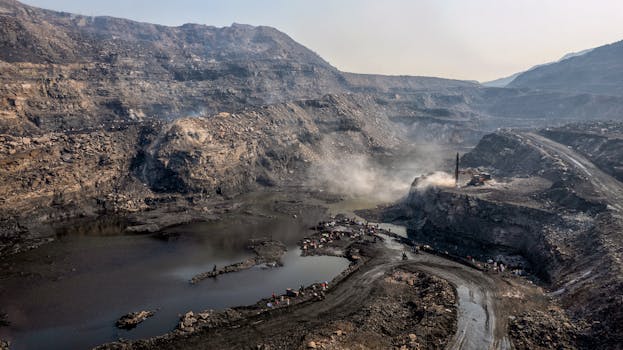
**
Hindustan Copper and Coal India Forge Strategic Partnership: Securing India's Critical Minerals Future
India's ambitious push towards self-reliance in critical minerals has received a significant boost with the signing of a Memorandum of Understanding (MoU) between Hindustan Copper Limited (HCL) and Coal India Limited (CIL). This landmark agreement aims to synergize the expertise and resources of both public sector behemoths to explore, mine, and process critical minerals crucial for India's burgeoning electric vehicle (EV) industry, renewable energy sector, and national security. The partnership marks a pivotal moment in India's drive for mineral independence and strengthens its position in the global critical minerals supply chain.
This strategic collaboration promises to unlock significant opportunities in the domestic critical minerals mining sector, addressing concerns about reliance on foreign suppliers. The move is in line with the government's initiatives to promote Atmanirbhar Bharat (Self-Reliant India) and ensure the availability of essential materials for various strategic sectors.
Unlocking Synergies: HCL and CIL's Complementary Strengths
Hindustan Copper, a Navratna company under the Ministry of Mines, brings its extensive experience in copper mining and exploration to the table. Its expertise in geological surveying, mine development, and mineral processing will be invaluable in identifying and extracting critical minerals co-located with copper deposits.
Coal India, the world's largest coal producer, possesses a vast network of infrastructure, including exploration and mining expertise, logistics capabilities, and extensive land holdings. This established infrastructure will significantly reduce the time and cost required for exploration and extraction, accelerating the development of critical mineral resources.
The partnership leverages the complementary strengths of both organizations, creating a powerful synergy that promises faster and more efficient exploration and production of critical minerals.
Focus on Critical Minerals: The Strategic Imperative
The MoU specifically targets the exploration and extraction of critical minerals like cobalt, nickel, lithium, and rare earth elements (REEs). These minerals are essential components in the manufacturing of advanced technologies, including:
- Electric Vehicle (EV) Batteries: Cobalt, nickel, and lithium are critical components of lithium-ion batteries powering electric vehicles, a sector witnessing exponential growth in India.
- Renewable Energy Technologies: REEs are vital for the manufacturing of wind turbines, solar panels, and other renewable energy technologies crucial for India's transition to cleaner energy sources.
- Defense and Aerospace: Critical minerals are also essential components in the manufacturing of advanced defense systems and aerospace technology, contributing to national security.
Addressing Supply Chain Vulnerabilities: A National Priority
India's current dependence on imports for several critical minerals creates significant vulnerabilities in its supply chain. Geopolitical instability and fluctuations in global commodity markets can severely impact the availability and cost of these essential materials. The HCL-CIL partnership aims to mitigate these risks by fostering domestic production and strengthening India's mineral security.
The initiative aligns perfectly with the government's emphasis on promoting domestic manufacturing and reducing reliance on imports. This self-reliance will not only enhance national security but also contribute to the country's economic growth by creating new employment opportunities and fostering technological advancements in the mining and metallurgy sectors.
Exploration and Production Roadmap: Key Milestones
The HCL-CIL partnership has outlined a phased approach to the exploration and production of critical minerals:
- Phase 1: Joint Exploration: Initial efforts will focus on identifying and assessing potential deposits of critical minerals co-located with copper deposits across HCL's operational areas. This phase will involve detailed geological surveys, geophysical investigations, and geochemical analysis.
- Phase 2: Pilot Projects: Successful exploration will be followed by pilot projects to test the viability of extracting critical minerals from identified deposits. This will involve developing and optimizing extraction techniques and evaluating the economic feasibility of the projects.
- Phase 3: Large-Scale Production: Upon successful completion of pilot projects, the partnership will move towards large-scale production of critical minerals, integrating HCL's mineral processing expertise with CIL's extensive logistical capabilities.
Boosting India's Global Competitiveness in the Critical Minerals Market
The HCL-CIL collaboration positions India to become a significant player in the global critical minerals market. This strategic partnership will not only enhance India's self-reliance but also create opportunities for export and generate revenue through the sale of these critical materials. The initiative will also contribute to technological advancements in the mining sector and foster the development of a robust domestic ecosystem for the processing and utilization of critical minerals. This will ensure India's competitiveness in emerging technologies and the global economy.
Conclusion: A Path to Self-Reliance and Global Leadership
The MoU between Hindustan Copper and Coal India is a significant step towards securing India's future in the critical minerals landscape. By leveraging the combined strengths of two leading public sector undertakings, the partnership promises to unlock substantial resources, enhance national security, and position India as a global leader in the production and utilization of critical minerals. The success of this collaboration will serve as a model for future public-private partnerships in the mining sector, fostering growth and innovation while ensuring India's self-reliance in a sector of paramount importance for its economic and strategic future. The initiative is a crucial element of India's broader plan to achieve mineral self-sufficiency and secure its place in the rapidly evolving global landscape of critical materials.




















